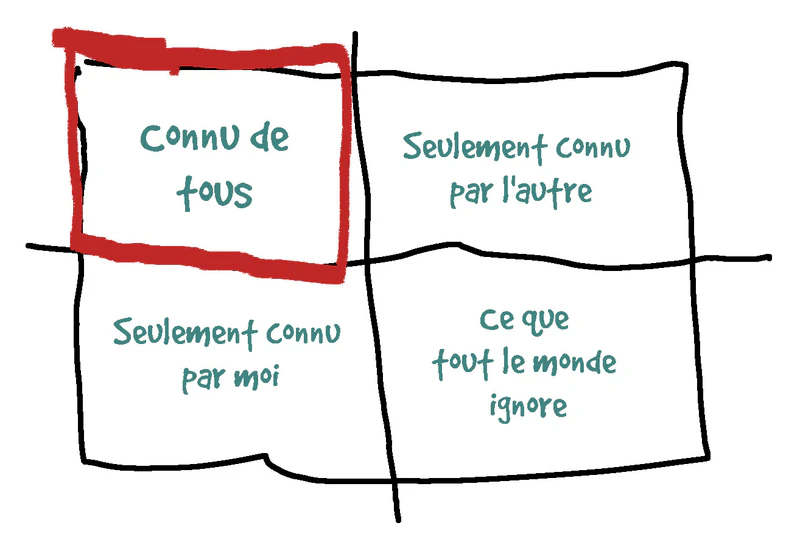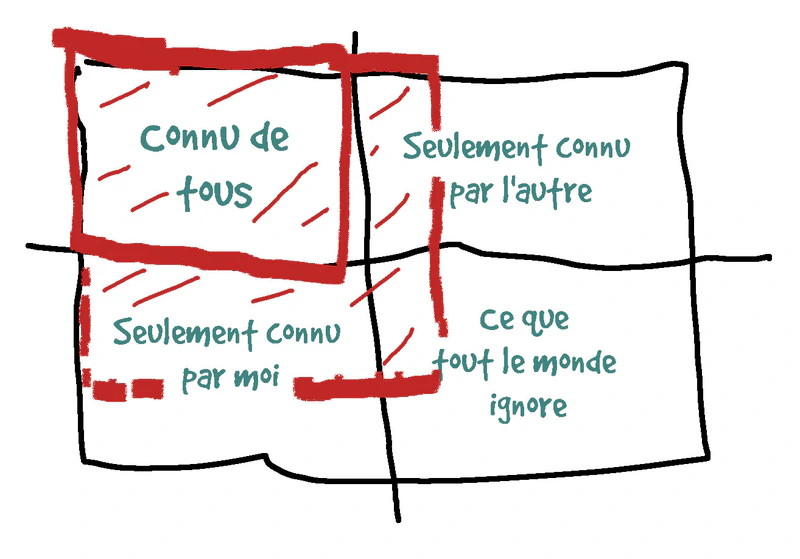I regularly advocate for the value of genuine authenticity (and genuine integrity). This doesn’t mean being obtuse and closed-minded. It blends quite a few ideas like having good intention, good posture, consistency between one’s words and actions, #nobullshit, #skininthegame and other things. My goal here is to talk to you about a short journey presented recently to a few teams at beNext on storytelling and the Johari window which simply shows the virtues of authenticity.
The Johari window
The Johari window is an interesting little diagram about known and unknown areas between people. There’s the “known by everyone” zone, the “only I know this” zone, the “only they know this” zone, and finally the “what we don’t know” zone.
The whole point is to enlarge the window within the window. At the beginning everyone only knows what’s in the top left square (“what everyone knows”).

It’s by revealing things about yourself that you allow your interlocutor to reveal things about themselves. And together you can discover the zone ignored by both of you.

Example: If you tell them what music you like (you reveal your space), they might tell you which one they like (they reveal a piece of their space) and you might both discover that you had the same music teacher (you reveal the space unknown to each).
If you don’t open up, don’t expect the other person to do so spontaneously. And neither will discover that common zone ignored by both.
Storytelling
I mentioned this Johari window to encourage people at beNext to talk about themselves authentically when they talked about beNext. And by talking about themselves authentically they would reveal themselves, which would help their interlocutors to do the same, and they might discover things together.
To have this dialogue, the best approach is to do storytelling. I brought out an old workshop done with Oana Juncu (in 2013?). As she says so well: “the brain is wired for stories”. We remember a story much better than a simple monologue. For transmitting, memorizing, and making yourself understood nothing beats a story. Moreover, you won’t be able to tell what you don’t understand. But then what is a story? In broad strokes, here are the components of a story:
- What is the heart of the subject?
- Who is/are the protagonist(s)?
- What is the setting?
You need to set the scene, its protagonists and make the heart of the subject clearly understood.
- What is the problem? The obstacle?
- What is the trigger?
A story has a situation that must change, there’s a dynamic, a problem, an obstacle, and a trigger that pushes the protagonist(s) to change the situation (the setting).
- Can you describe the path toward resolution?
- What is the outcome and what is the new situation?
This change of situation generally occurs in several clear stages that lead to a resolution and therefore a new state of affairs.
Conclusion
By telling a story about a subject, you enable much better memorization and transmission. By telling your story about a subject you authentically reveal yourself by unveiling an obstacle, a problem and your resolution steps. In doing so you reveal your space in the Johari window and you will surely have the chance to see your interlocutor’s space revealed and to share a space unknown to both of you.